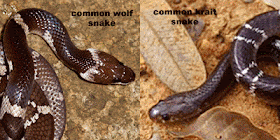No, its not. Believe it or not, it’s Common Vine snake. Seriously, I’m not joking. Because there is a specimen in my own backyard which pretty much everyone of my family have seen except me, ‘cause whenever I look at the picture of it, I say to myself, “man, where did it got those snouts!!” I mean really, it is such a comic looking snake.
Now on this morning, it was a bit cloudy, I went out to a un-habitated place beside our river in a hope to capture some butterflies. I was looking for them every where but as my luck turned towards worse, I didn’t even find a single one. Suddenly a vine caught my attention. The area was thickly vegetated and was full of bushes and vines and creepers and all but this particular one on a low bush was different. Other vines have a shiny surface but this one has a matt surface. But then which vines have a matt finish that is because they have got tiny hair like growths on the surface which this one lacks. Now I got real closer and to my surprise found smooth scales on the surface.

Bingo!! I have found a snake. But what was it?? My heart was beating fast,” boy you have found what you wanted to see for years” but I have to be cautious, ‘cause it could be say a green pit viper for an example. So I followed the trail(the tail) into the bush only to find out a comic looking face welcoming me. Well, in that moment I thought so. It was a beautiful green snake. And it was huge, bigger than any of the vine snakes I have seen in Chennai Snake Park, around 4.5ft long.

As soon as I started to take pictures it was going away. So I had no choice but to grab its tail with one hand to stop it from escaping. But as I grabbed its tail it started a spectacular show. First it dilated its forebody. So, what was a smooth green snake now became a checkered maze of black and white with green. When further threatened, it opened it jaws, retracted its tongue and what I was seeing was a wide open pink mouth. And it also coiled itself in a sigmoid curve to strike at the least provocation. Though it gave me a spectacular opportunity for photography, it was clear that the sign it was displaying was,” KEEP YOUR A** OFF”.

When I released it, whosh! And it was gone. I mean it was so smooth in the action that hardly a leaf had moved. Good bye beautiful friend, see ya later…
Natural History
These snakes are of bright green above and light green below. A thin white line can be found on each side of this snake. It is a common snake of India except the North-East and Northern India. Average size of this snake is about 39 inch but it can reach upto 6ft. It is a diurnal snake meaning it roams about in daylight. Commonly found on low bushes and trees but rarely on ground. I actually saw one crossing a road and I bet if I had uploaded the video to youtube it would have been the funniest video. It is terrible on ground but it is so well adapted to trees that it will get support from the tiniest of twigs. Generally it is a gentle snake but can be quite fierce when captured and does a spectacular threatening display. It generally feeds on small mammals, birds, lizards, fish, frog etc.
It is from the group lacepede meaning rear fanged and is mildly venomous. The symptoms are quite like cobra venom but usually venom has no effect on human. Although secondary symptoms like swelling, numbness of the bitten area could appear.





